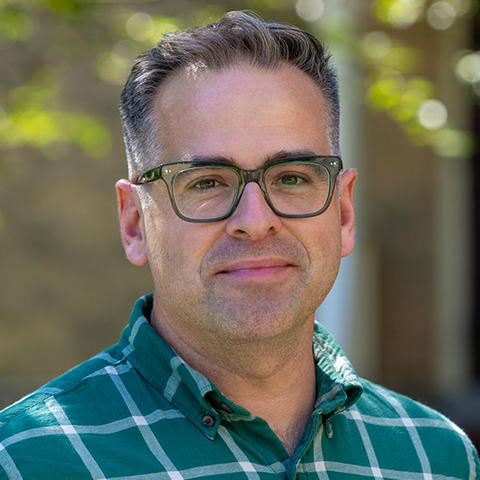Professor Jonathan Wilson Receives NSF Grant to Advance Understanding of Ancient Plant Communities

Associate Professor of Environmental Studies Jonathan Wilson in his office with several plant fossils. Photos by Patrick Montero.
Details
The three-year grant will allow Wilson, his colleagues, and students to build new models to learn more about periods of intense warming and atmospheric carbon dioxide in Earth’s ancient history.
Professor of Environmental Studies Jonathan Wilson’s office and lab in Sharpless Hall are replete with fossils of ancient ferns and early seed plants dating back hundreds of millions of years. Microscopic structures in their stems, now fossilized and encased in carbonate minerals, he says, may be key in understanding how plant communities responded to periods of intense warming and atmospheric carbon dioxide in Earth’s ancient history.
In partnership with his colleagues at Baylor University and Trinity College, Wilson has landed a three-year grant from the National Science Foundation to continue his investigation of ancient plant structures and the paleoclimate record. That work is particularly relevant, he says, as the world scrambles to address the growing threat of climate change.
“Understanding our vegetation and climate history helps us understand both how to make better models of the past and the future, but it also helps people learn what’s happened on the planet in deep time,” says Wilson. “Knowing how different scenarios in the Earth’s history ended is important for understanding what scenarios we could be staring down.”
Through the project, titled "Cells to ecosystems: fossil xylem is the missing link in reconstructing water use by plants, forests, and global vegetation in deep time," Wilson, his colleagues, and his students at Haverford will collect and study plant fossils from around the world to build new models of ancient plant communities and the carbon and water cycles during two pivotal moments in Earth’s history. Those models will simulate factors like photosynthesis and growth rate that can be incorporated into paleoclimate scenarios to provide a clear picture of how ancient ecosystems functioned.
Much of the focus will be on the structures of ancient plant stems, particularly xylem, the vascular tissue responsible for transporting water and nutrients through plants. While our modern flora bears outward resemblances to its ancestors — an ancient fern would be recognizable as a fern, for instance — their vascular structures are dramatically different, Wilson says.
“There’s not a living plant today that grows or functions the same, so we’ve been spending a lot of time over the last decade putting these plants back together and building new models to answer questions about how they work or how fast they can grow,” he says.

Wilson and his colleagues' analysis will begin 300 million years ago. That’s when rainforests along the equator formed most of eastern North America’s coal before suddenly collapsing. They’ll also explore a period 100 million years later, when a significant greenhouse gas spike, not unlike what the world is experiencing now, triggered mass extinction.
“Knowing what some of the extreme scenarios Earth has faced can help people understand the urgency of our current problem,” Wilson says. “The last time we think carbon dioxide was 600 parts per million, which is not an unreasonable projection for the end of the 21st century, we had reptiles up in the Arctic Circle. That’s a very different world than the one humanity has become used to. Unless we want to live in that world, we really need to take steps to address it now.”
The NSF grant will also teach Wilson’s modeling methodology to undergraduate and graduate students through summer courses at Haverford. Wilson says he expects the first course to launch in summer 2025 and hopes that it will inform the next generation of scientists on how to conduct the interdisciplinary approach to modeling he and his colleagues have pioneered. The course will also be carefully evaluated by Justina Ogodo, an assistant professor in Baylor’s Department of Curriculum & Instruction, to identify improvements for future iterations.
“One of the really special things about this project that I am excited about is that Justina will be evaluating the pedagogy of our workshops,” Wilson says. “We brought Justina in to help us evaluate whether or not this type of interdisciplinary workshop is a good way of teaching climate, earth science, and biophysics to students. What are they coming in with, and what are they learning? We hope it makes an impact.”




